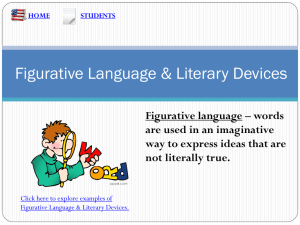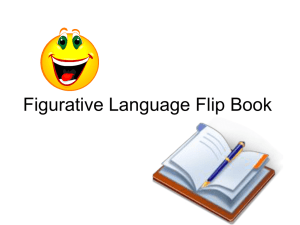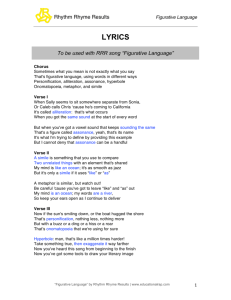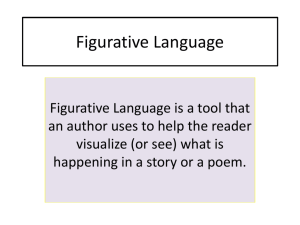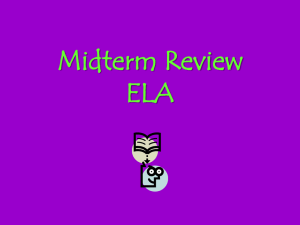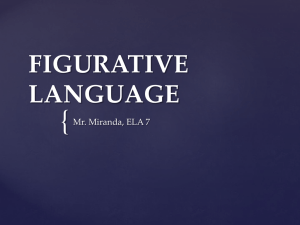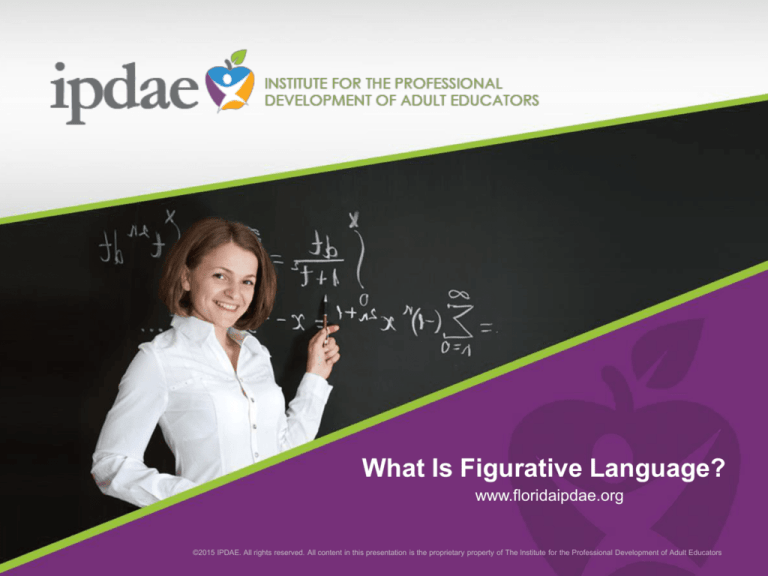
What Is Figurative Language?
www.floridaipdae.org
©2015 IPDAE. All rights reserved. All content in this presentation is the proprietary property of The Institute for the Professional Development of Adult Educators
What is figurative language?
What Is Figurative Language?
Think of figurative language as a way of saying
one thing and meaning another. It is a way of
using words and phrases that are different from
the literal (or dictionary) meaning.
Figurative language uses exaggerations or
alliterations to provide meaning.
©2015 IPDAE. All rights reserved. All content in this presentation is the proprietary property of The Institute for the Professional Development of Adult Educators
Examples of figurative language
For example, many advertisements use words
and phrases that persuade consumers to
purchase a product or service.
Feeling thirsty yet?
©2015 IPDAE. All rights reserved. All content in this presentation is the proprietary property of The Institute for the Professional Development of Adult Educators
A Resource from the World Wide Web
http://grammar.yourdictionary.com/styleand-usage/Figurative-Language.html
©2015 IPDAE. All rights reserved. All content in this presentation is the proprietary property of The Institute for the Professional Development of Adult Educators
Common types of figurative language
There are many types of figurative language.
In this presentation, we will be focusing on those
most commonly used in media print.
Metaphor
Simile
Personification
Hyperbole
Symbolism
Onomatopoeia
Alliteration
Idiom
©2015 IPDAE. All rights reserved. All content in this presentation is the proprietary property of The Institute for the Professional Development of Adult Educators
What is a metaphor?
What is a metaphor?
A metaphor is when you compare things
that are essentially not alike.
©2015 IPDAE. All rights reserved. All content in this presentation is the proprietary property of The Institute for the Professional Development of Adult Educators
What is a simile?
What is a simile?
A simile is similar to a metaphor. The
difference is that a simile uses the words
“like” or “as”.
©2015 IPDAE. All rights reserved. All content in this presentation is the proprietary property of The Institute for the Professional Development of Adult Educators
What is personification?
What is personification?
Personification is when you give
human-like qualities to something that
is not human.
©2015 IPDAE. All rights reserved. All content in this presentation is the proprietary property of The Institute for the Professional Development of Adult Educators
What is hyperbole?
What is hyperbole?
A hyperbole is an exaggeration. It is
usually used in a humorous way.
©2015 IPDAE. All rights reserved. All content in this presentation is the proprietary property of The Institute for the Professional Development of Adult Educators
What is symbolism?
What is symbolism?
Symbolism occurs when you use a noun
with a particular meaning to represent
something different.
©2015 IPDAE. All rights reserved. All content in this presentation is the proprietary property of The Institute for the Professional Development of Adult Educators
What is onomatopoeia?
What is onomatopoeia?
Onomatopoeia is when you name an
action by imitating the sound that is
associated with it.
©2015 IPDAE. All rights reserved. All content in this presentation is the proprietary property of The Institute for the Professional Development of Adult Educators
What is alliteration?
What is alliteration?
Alliteration is the repetition of the same
sound at the beginning of words that are
adjacent or closely connected.
©2015 IPDAE. All rights reserved. All content in this presentation is the proprietary property of The Institute for the Professional Development of Adult Educators
What is an idiom?
What is an idiom?
An idiom is an expression that is used by
a group of people and that is understood
only by common use.
©2015 IPDAE. All rights reserved. All content in this presentation is the proprietary property of The Institute for the Professional Development of Adult Educators
Figurative language in advertising
You now have just viewed examples of print media
that feature various figurative language devices.
Let’s watch a brief video clip from YouTube for a
few more examples:
https://youtu.be/5EqG5v07R24?list=PLjDn6
h5FDTQtkmeAdgZdDGVZdUqCXC_DE
©2015 IPDAE. All rights reserved. All content in this presentation is the proprietary property of The Institute for the Professional Development of Adult Educators
Review and assessment
Directions:
Match each of the figurative language devices below with
the appropriate example.
A.
B.
C.
D.
E.
F.
G.
H.
Metaphor
Simile
Personification
Hyperbole
Symbolism
Onomatopoeia
Alliteration
Idiom
__ Don’t pay an arm and a leg for car insurance.
__ Plop, plop, fizz, fizz. Oh, what a relief it is!
__ Diamonds are forever.
__ The car that’s like a Toyota.
__ Enjoy a Kit Kat candy.
__ Buy American made.
__ So easy … a caveman can do it!
__ Tony the Tiger loves Frosted Flakes. He says,
“They’re great!”
©2015 IPDAE. All rights reserved. All content in this presentation is the proprietary property of The Institute for the Professional Development of Adult Educators
Review and assessment
Directions:
Match each of the figurative language devices below with
the appropriate example.
A.
B.
C.
D.
E.
F.
G.
H.
Metaphor
Simile
Personification
Hyperbole
Symbolism
Onomatopoeia
Alliteration
Idiom
H.
F.
D.
B.
G.
E.
A.
C.
Don’t pay an arm and a leg for car insurance.
Plop, plop, fizz, fizz. Oh, what a relief it is!
Diamonds are forever.
The car that’s like a Toyota.
Enjoy a Kit Kat candy.
Buy American made.
So easy … a caveman can do it!
Tony the Tiger loves Frosted Flakes. He
says, “They’re great!”
©2015 IPDAE. All rights reserved. All content in this presentation is the proprietary property of The Institute for the Professional Development of Adult Educators
Thank You
By Educators For Educators
www.floridaipdae.org
Thank You!
©2015 IPDAE. All rights reserved. All content in this presentation is the proprietary property of The Institute for the Professional Development of Adult Educators

